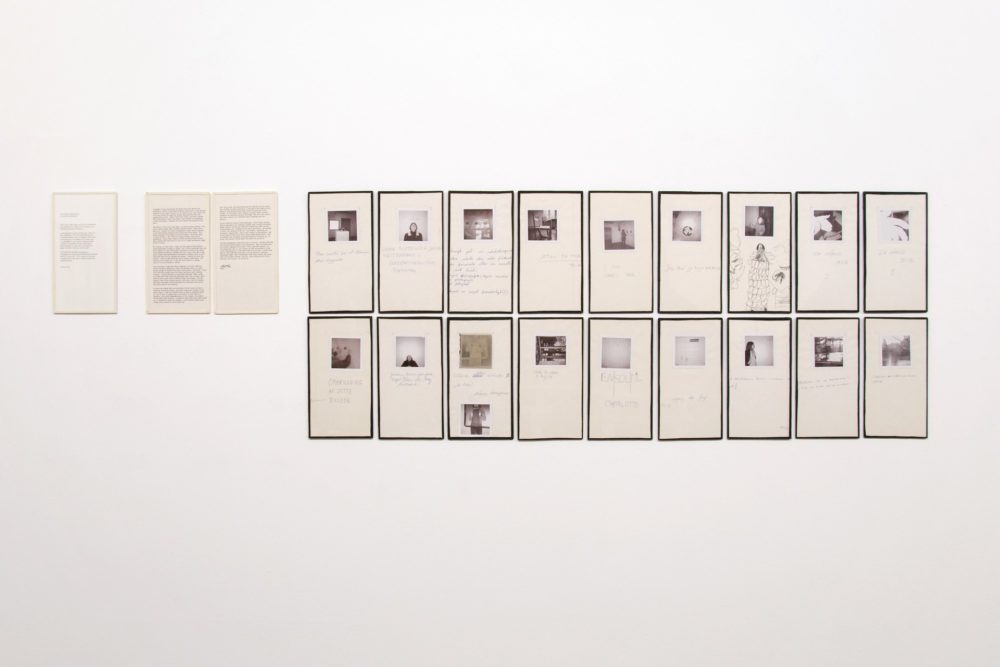A Danish Exorcism
En dansk Uddrivelse
CR 50. Year 1976

- EN
- DE
I wonder if you remember the first time you went to an exhibition. When I was about sixteen years old, a new gallery opened on the road I took to go to school in D. One could see from the street through the empty shop-window into the empty show-room, which must have been a grocery before. The impression I got from what I saw inside is something I still remember, despite the time which has passed since then.
Jochen Gerz sees himself as an acting subject and an affected object. He can verify "the real distance (alienation) between the artist and his public", between Ich ("I") and Es ("it"), reality and work verified by existence. He places himself in a dialectic inversion, that is, as an antithesis to the conventional understanding of a work of art, which he counters with his life experiences and the conditions surrounding each project he undertakes.
Andreas Vowinkel 1992
Since the 70s art in public space has been engaged in producing new forms of public awareness … Jochen Gerz succeeded in carrying this idea on to the present day without giving in to a formal dogmatism, but by constantly renewing it under specific and new conditions. His artistic activity often confines itself to minimal interventions within a given context. By creating a frame or by finding a crack in the visible order, potential new spaces open up, within which people constitute themselves as authors, move around, articulate themselves and are able to interact – heterotopias, within which alternative forms of socialisation playfully manifest themselves. The freeing of imagination however does not lead into virtual worlds that exhaust themselves in art’s residuum but is always tied to the specific perspective of the life of individuals.
Guido Meincke 2009. Translated by e_CR editors
Zeitgenössische Kunst im ‚öffentlichen Raum‘ sieht ihre Aufgabe spätestens seit den 70er Jahren vor allem darin, neue Formen von Öffentlichkeiten zu schaffen. … Jochen Gerz hat es verstanden, diese Idee bis in die Gegenwart zu tragen, ohne einem Dogmatismus der Form zu verfallen, sondern sie immer wieder unter neuen und anderen spezifischen Bedingungen zu aktualisieren. Seine künstlerische Tätigkeit beschränkt sich dabei häufig auf minimale Interventionen in bestehende Zusammenhänge, auf die Schaffung eines Rahmens oder die Öffnung eines Spalts in der sichtbaren Ordnung, durch den sich potentielle Räume auftun, in denen sich Menschen als Autoren konstituieren, sich bewegen, sich artikulieren und interagieren können – Heterotopien, in denen sich alternative Formen von Vergesellschaftung spielerisch manifestieren. Die Befreiung der Phantasie führt aber nicht in virtuelle Welten, die sich im Residuum der Kunst erschöpfen, sondern sie wird systematisch zurückgebunden an die konkrete Perspektive des Lebens jedes Einzelnen.
Guido Meincke 2009
Categories
Keywords
Performance / Installation
Table, 2 chairs, 2 Polaroid cameras, Polaroid film, text (typed on paper), 29.5 x 21 cm
Visitors to the exhibition are invited to create the exhibits themselves. They take Polaroid photographs and write their own texts. During the exhibition, 65 contributions are produced by visitors of the exhibition.
Wilhelm-Lehmbruck-Museum, Duisburg
Exhibition
Tranegaarden 1976
Bibliography
I: Tranegaarden 1976, pp. 2-31. Bern 1977, pp. 116-117. Paris 1980a, pp. 58-59. Hannover 1982, pp. 67-70. Bielefeld 1985, pp. 35-36.
II: Red. 5, 1976. Red. 6, 1976. Schade 1976, p. 6. Zürich 2000, p. 84
III: Vipecker Raiphan 1981, pp. 42-44
Documentation
Left over polaroids
Exhibitions of the documentation
Bern 1977. Paris 1980 (Grenoble 1980. Saint-Étienne 1981). Hannover 1982 (Amsterdam 1982). Silkeborg 2022